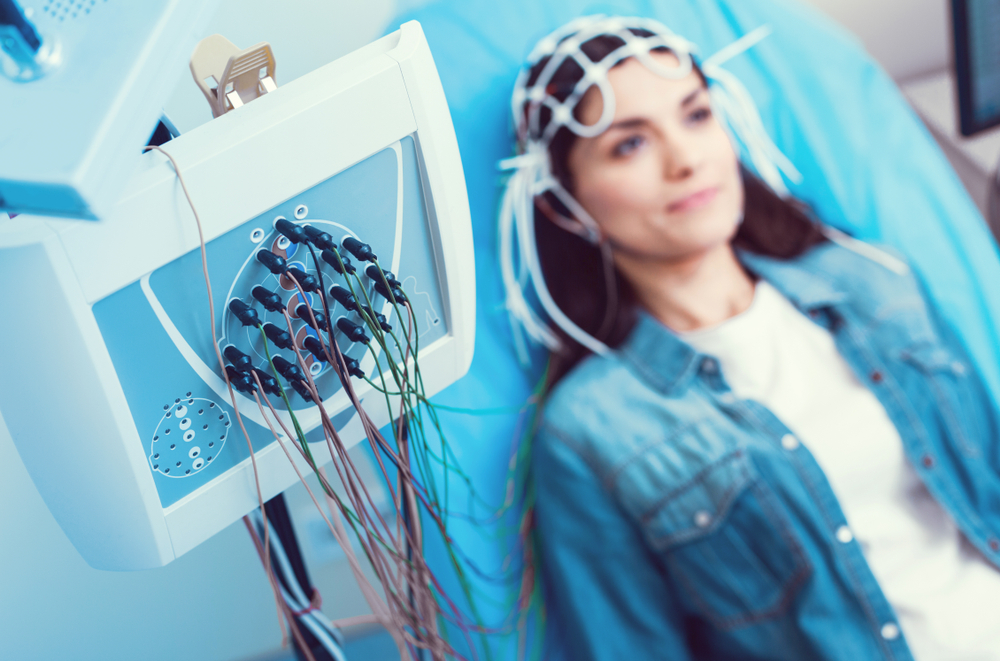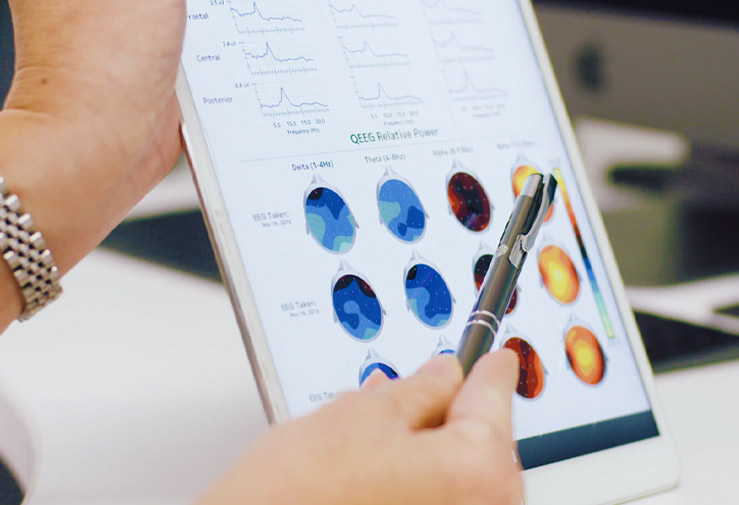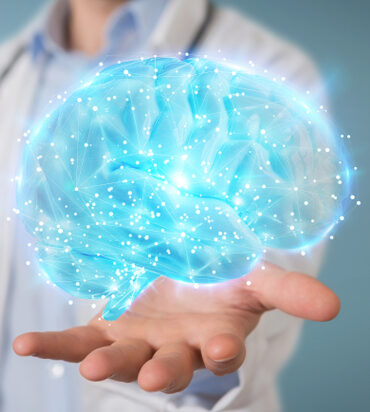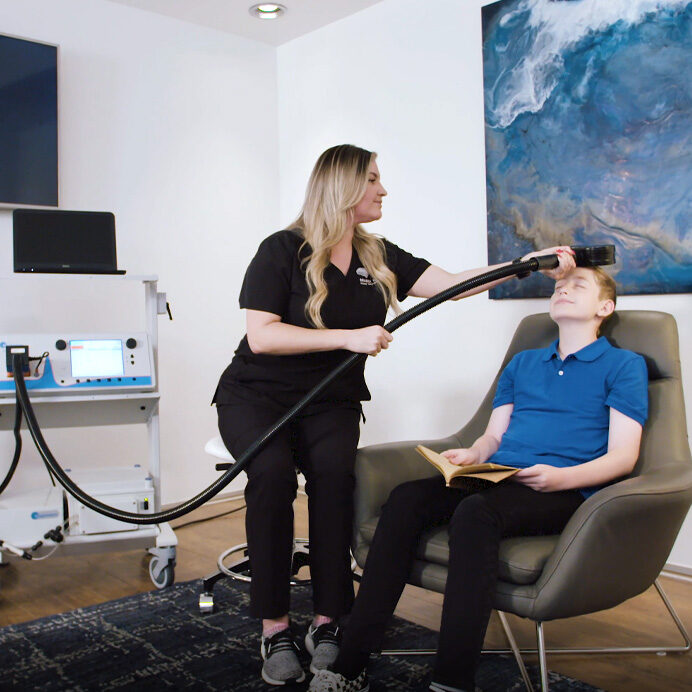What is MeRT?

MeRT is a treatment modality that can greatly improve your quality of life, however, if you are under the care of another type of physician or therapist, we encourage you to continue to see them for your primary care.
What is MeRT?
MeRT, or Magnetic e-Resonance Therapy, is a state-of-the-art treatment modality that can be used to treat areas of the brain that are not operating in sync with each other. The brain is a bundle of organized electricity consisting of neurons and pathways. When those pathways are disrupted or out of sync, the brain cannot operate effectively or communicate with itself optimally.
- It’s a form of rTMS
rTMS, or repetitive Transcranial Magnetic Stimulation has been used for years to treat brain dysregulation associated with various neurological conditions. - MeRT vs rTMS
MeRT utilizes rTMS but is much more effective because MeRT is a customized and tailored approach specifically for YOUR brain. - Features of MeRT
MeRT is non-invasive, DRUG-FREE, and painless. - MeRT and other therapies
If you are utilizing other types of therapies, MeRT can help to accelerate your progress through those as well.
Many patients who have been on medications may have also suffered side effects or the medication may not be as effective as it should be. MeRT can treat some conditions so that meds are no longer needed. Your clinician will work with your primary care provider in regard to medication changes, etc.
The qEEG is the Key
A qEEG, or quantitative electroencephalogram, is used to measure the electrical patterns in the brain to create a “brain map.”
This test shows exactly where in the brain dysregulation may be occurring. A qEEG is the first step in MeRT treatment because once the results are analyzed and interpreted by your physician and brain scientists, a precise treatment protocol can be created specifically for what is going on in your brain.
Everyone’s brain is different; yours is as unique as your fingerprints. Additionally, your brain may be operating at different hertz than someone else. TMS is more of a generalized approach since there is no qEEG – guidance.
Because MeRT incorporates the qEEG with TMS, it is a targeted approach for your brain patterns.



Any dysregulation associated with multiple conditions will show up on the qEEG. Your customized treatment protocol based on the EEG results will target all areas of the brain, and thus treat all of your symptoms simultaneously.
Conditions Treated
There is a variety of health conditions that can be effectively treated by MeRT including, but not limited to:
- Depression
- Anxiety
- Autism
- TBI (traumatic brain injury) and post-concussive syndrome
- PTSD (post-traumatic stress disorder)
- After-effects of stroke
- Mild cognitive decline
- Dementia
- Parkinson’s disease
These types of conditions show different patterns of brain (or neural) oscillations indicative of brain dysfunction.
MeRT is used to realign, or neuromodulate, the brain waves so that they can operate in sync. A gentle magnet is placed against the scalp which helps to pull the pathways back into place. Additionally, if there has been damage or injury to the brain, MeRT can help to generate new pathways in the brain.
It’s common for some mental health issues to occur simultaneously. For example, you may be experiencing depression and anxiety or have had a traumatic brain injury that has caused you to be depressed or experience PTSD.
Your Brain is Like a Symphony
To better explain how MeRT works in layman’s terms, think of the healthy brain as a perfectly orchestrated symphony. When the brain is not communicating as it should, the neural pathways in the frontal lobe are not on the same wavelength as the pathways in the back of the brain.
If you’ve ever listened to an orchestra or symphony warm-up before a performance, it sounds like everyone is off-key. But, once the performance starts and everyone is in the same key, the music sounds harmonious and fluid.
When brain signals are not communicating effectively, they are out of sync with each other, and are “out of tune.” MeRT treatment gently pulls those signals and pathways back together in sync so that like a symphony, your brain is all in the same key.


Benefits of MeRT
MeRT has many benefits that can include:
- Improved sleep
- Improved relaxation (less nervousness or anxiety)
- Better concentration and focus
- Improved mental clarity
- Better mood
- Increased ability to cope with stress
- Increased motivation
- Improved emotional stability
- Increased attention span
- Better sociability
- Better ability to adapt to change
- Improved self-confidence and self-esteem
** Results are not guaranteed. Most patients will experience benefits, however not all react as well. If changes are not noted clinically OR on the repeat qEEG, your clinician can advise you on whether or not you should continue with treatment after the initial 2-4 weeks.
How Long Does Treatment Last?
The treatment sessions last 30-minutes and are administered every day, Monday through Friday.
Generally speaking, MeRT takes about 6-weeks to be long-lasting and effective. For some, it may take a little longer; it depends on your specific condition and how your brain reacts to treatment.
The qEEG is repeated every two weeks which will show whether or not your brain is responsive to treatment. Your clinical progress is also tracked during your daily visits to the clinic. Some patients may feel immediate improvements starting within the first week or two. For others, it may be week 3 before you start to notice significant changes.
In most cases, treatment will last a lifetime and doesn’t need to be repeated after the initial 6-8 weeks. For others, especially those with autism, you may have further benefits from a periodic short period of treatment.

No two brains are the same and thus no two treatment programs are the same either. Each patient’s therapy protocols are mapped based on their individual diagnostics.

The TMS equipment used in MeRT treatment is FDA-cleared for the treatment of depression and OCD. Currently, it is used off-label for all other conditions. There are research studies being conducted through Texas A&M University for FDA approval for the treatment of PTSD; these studies are underway in Texas and California.
What are the Side-Effects of MeRT Treatment?
The most common side-effect of MeRT is a slight headache after treatment. This can easily be treated with a pain reliever such as Ibuprofen or Tylenol. These types of slight headaches should subside as you get used to the treatment.
Another side-effect may include a slight increase in symptoms for a short time period while your brain gets used to the treatment, though this doesn’t happen to everyone. MeRT is a therapy for your brain and will involve changes in the neural pathways.
It is similar to starting physical therapy or an exercise program if you have been inactive for a while. In the beginning, your body might experience some soreness because you are using muscles that haven’t been used for a while. But, as you continue with your exercise program, you will start to feel less sore and as more time goes on, you won’t experience any soreness at all.
Some people report feeling fatigued after treatment. This is because the treatment stimulates the neurons in your brain which causes your brain to use more energy than usual. A light snack after your treatment session can help prevent fatigue.
There is a very slight risk of seizure with MeRT. However, a seizure has never occurred as a side effect when the patient does not have a history of seizures. To give you a better idea of how slight the risk of seizure is, we can compare the use of a Game Boy or Nintendo video game versus MeRT. The risk of seizure from using these video games is 1 in 4,000. The risk of seizure from MeRT is 1 in 150,000.

Army Delta Force operator & how MeRT changed his life
It was absolutely terrifying to not know what was wrong with me or how to fix the problem. BTC not only identified the deteriorated state of my brainwave activity, they restored its function… I consider the healing I experienced at BTC to be nothing short of a miracle.”
– Retired Army Delta Force operator, Scott Spooner
Taking the First Step
The first step is contacting the patient coordinator for the clinic that you want to treat with. She can answer all of your questions and advise you of the protocols and fees for the specific clinic.
Once you decide to move forward with treatment, you will be scheduled for your qEEG and a consultation with the physician/clinician at the clinic. During the consultation, you will receive the results of your qEEG/brain map. The doctor can interpret the results for you and explain how MeRT can help. Should you decide to proceed with treatment, the clinic will get you on a regular schedule for your daily treatments.

Because MeRT uses a magnet to administer treatment, not everyone is a candidate for treatment.
Relative contraindications may require closer or adjusted protocols, but do not necessarily disqualify someone from receiving MeRT treatment including:
- History of seizures or seizure disorder
- Titanium shunts or stents
- Spinal cord stimulator
- Non-removable hearing aids
- Ferrous cortical implants
- Magnetic ink tattoo
- Bipolar disorder, Type I/II
- Baha implant
Absolute contraindications include:
- Pacemaker
- Defibrillator
- Vagal nerve stimulator
- VP Shunt/Magnetic intracranial shunts
- Deep brain stimulator
- Steel shunts/stents
- Cranial metal fragments, i.e., shrapnel
- Cochlear implant
- Aneurysm clips, coils, pipelines
- Pregnant or breastfeeding
- Primary brain cancer / metastatic legions in the brain
- Magnetic dental implants
- Implanted cardio defibrillators
- Ocular implants